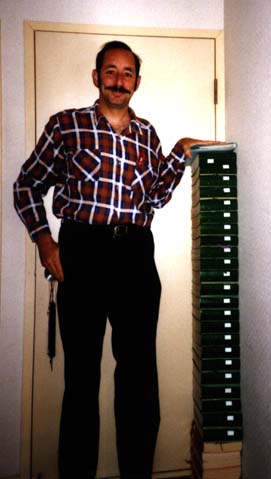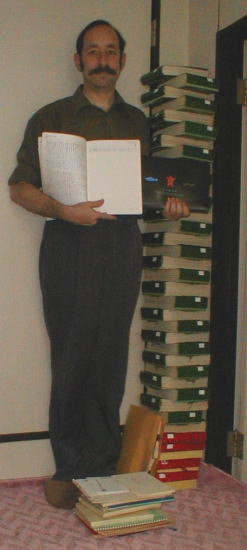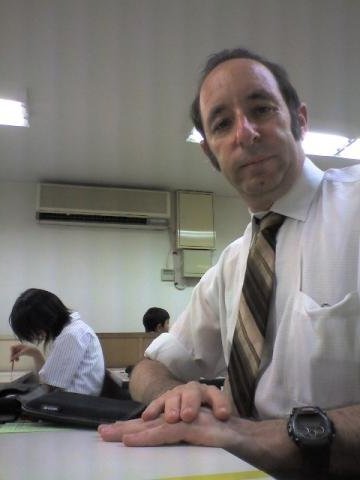
These are the Kumon pages I've done over the last years. I bet no one else has done so many. So how do I get in the Guinness Book of World Records? This picture was actually taken around 1996, and I've done lots more since then. I'll try to add another updated picture (if I can get my digital camera to work again). [Actually used a borrowed but much nicer one for the update.]

It wasn't supposed to be a trick photo and I'm not really a giant. It makes me look tall because of a combination of the angle and the short Japanese door. The stack is probably over four feet tall and has more than 10,000 pages.
Oh yeah! What is a Kumon page? It's a small piece of paper with exercises written on both sides. The original Kumon pages were for studying math, but the Kumon Institute makes them for various subjects and students. The ones at the bottom of the stack in the picture are actually the Japanese for foreigners pages that I started with many years ago. The ones on top (in the dark green binders) are the same ones the Japanese children can use to study Japanese. The bottom ones include a lot of translations, but the top ones only use Japanese.
The actual classes are twice a week, and some students do study there, but I think most students fill in the pages outside of class, as I do, mostly on the trains. In class the teacher or assistant checks the work, and then the student corrects any errors. Pretty simple system.
Many years ago I even did some part-time work for Kumon. A little teaching, a dab of teacher training, but mostly editorial consulting for an English speed reading course. However, I really wanted to help push the computer side of it. I really think they could produce an amazingly good CAI system mostly based on the worksheets they've already prepared over the years, but as far as I know, I never managed to sell the idea to anyone who could do anything about it.
The basic idea would be to convert the questions into a database on a CD, and the worksheets would be laser printed for each student, preferably with customization for that student. The crucial idea would be to balance a small number of questions the student knows well, a moderate number of less known questions being reviewed, a large number of questions that require a certain amount of thought and learning, and a small number of more serious challenge questions, mostly fishing for reverse gaps, places where the student might actually know something that previous results haven't shown or which were leaned somewhere else. All of this would basically be automatically driven by a complete record of each student's performance, with the teacher tweaking the parameters at a higher level.
The other side of this would be to automate the grading in various ways. Basically OCR could recognize most of the answers without teacher intervention, but more flexibly. The current system is geared around single correct answers, which is okay for basic math, but fundamentally different from how language really works. The computerized version of the system could have many acceptable answers stored in the database, as well as many incorrect answers with links to explanations for the student and appropriate follow-up or regression questions for the worksheets prepared afterwards. For answers that don't match in either category, the teacher would make the call, and the new answer would be collected and returned to Kumon headquarters for inclusion in the next update of the CD. But that's enough pie in the sky for now...
 The picture at the right is at the end of
my 44th year, and just after finishing my 12th full year in Japan. Sad to see that I haven't
really added that many pages in the last
few years, though I'm still doing them every
day. Part of the problem is that my train
commutes are shorter these days, but most
of it is just that the pages have gotten
a good deal harder.
The picture at the right is at the end of
my 44th year, and just after finishing my 12th full year in Japan. Sad to see that I haven't
really added that many pages in the last
few years, though I'm still doing them every
day. Part of the problem is that my train
commutes are shorter these days, but most
of it is just that the pages have gotten
a good deal harder.
The tall stack next to me has 31 green volumes and the same old four red volumes at the bottom. The black plastic thing in my hand is the new box they gave me for carrying the pages I'm currently working on, and at the bottom, between the stack and my foot is a big manilla folder that contains almost all of the Kumon tests I've taken over the years.
All of the Japanese pages are organized in blocks of 200 pages, with a little test at the end. Hard to do well on the tests, because they are scored both for time and accuracy--a high score means I'm reading that material as well as a Japanese kid, and for me that is limited to about 5th grade (elementary school) material, while I'm mostly studying 7th grade (junior high school) stuff now.
Each of the green folders has about 400 pages, so that's about 12,400 pages now. The red folders are kind of strangely done, with lots of extra pages outside the folders, but tied in with the string, so I'd estimate that there are about 3,000 pages there, for an estimated total of 15,400 pages. About 11½ years worth now.
Another helpful (but unpictured) study activity related to Kumon involved reading children's books. Kumon published these little guidebooks describing books they recommended for each age of student, and I read several hundred of their recommended books, though mostly at the lower levels. Not quite sure where the latest one has gotten to, but for most of those books I did not count them as regular books for my book list, but only wrote the date in the guidebook. However, I stopped doing this a couple of years ago.
The little stack in front of my feet are practice notebooks I've filled up. That's basically just copy practice, and the one I'm holding is open to my current place, page 91. I often alternate colors with black one day and blue the next, though these days I'm often too busy to write every day. Sometimes I just copy from a book, but in recent years I'm usually copying a textbook of some kind, so I also try to do the exercises as I go, though the main focus is just on writing Japanese. Not related to Kumon, and I normally don't put that much time into it.
Since I've diverged from Kumon a bit, I'll go ahead and briefly mention conversations schools I've dealt with over the years--and there have been lots of them. Obviously, I've never been as satisfied with a conversation school as I have been with Kumon, but the sad reality is that speech is primary and my reading focus has surely limited my overall progress. A lot of the classes were associated with schools I taught at in my early years in Japan. I also paid for a number of courses at Nichibei and ALA and studied more briefly at Sony's Language School and a weird school called Kai. There were probably others I can't even remember now. There were also some classes given by volunteers in Itabashi-ku and Koufu-shi and Kawasaki-shi, and a year of exchange lessons with a very nice lady dentist. Recently I took a course at the YMCA, but now I'm studying at the Kokusai Bunka Kouryu Center in Kyodo. Basically more exchange lessons, but kind of complicated...

Sorry about the alignment around this photo, but this seems to be the easiest way to handle it with this new HTML editor, bluefish.
Still at it (my Kumon Study) after all these years, eh? I should make another grand picture of the stacked pages, but that's a lot of work. Maybe in a few more years? I still have them, though the stack is growing more slowly these days. I took this picture in my regular class a few days ago. This is the school near Sagami-ono Station where I've been studying for about 8 or 10 years by now. I guess I feel pretty settled in by now, and I've even started using the barber on the ground floor. (My old barber shop in Kanda finally shut down a year or two ago.) The picture shows me sitting at a little desk while the instructor is checking my latest work.
I feel like I should try to come to some conclusion from the years of study, but what is there to say? I basically like the Kumon system, but my Japanese has pretty much stopped improving, and now I see the Kumon study as mostly maintenance work. I probably peaked some years ago. At that time I was mostly studying at the G level, which is targeted at the first year of junior high school, and these days I'm struggling hard with the F and E levels that are for students in the last two years of elementary school.
My Japanese study blog is basically where I've been doing a bit of occasional scribbling about Kumon pages that have given me trouble.
For other Japanese study, the main thing is that I'm reading more Japanese books again, after a period when I wasn't reading many of them. Mostly I've been enjoying non-fiction targeted at kids. Earlier this year I finished a manga series on the history of science, which was quite interesting. Currenly I'm more than halfway through a slightly easier series of books about the origins of names. It isn't a full-blown manga, though they are heavily illustrated and probably targeted around fourth graders, whereas the history of science series was probably intended for sixth graders or even junior high students.